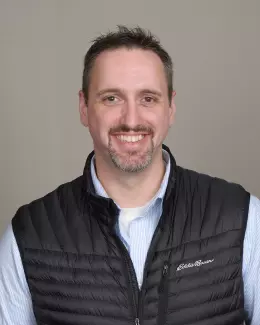- AdventHealth
Choose the health content that’s right for you, and get it delivered right in your inbox.
The American Cancer Society expects the U.S. to see more than two million new cases of cancer in 2024. That comes out to 5,500 cancer diagnoses a day. Groundbreaking cancer treatment is happening at AdventHealth hospitals in the Rocky Mountain Region thanks to the work of Michael Tallhamer, Chief of Radiation Physics. We are currently using a variety of technologies that not only decrease treatment times, but also ensure the highest quality of care in our patients.
We want to make sure our patients are getting the exact dose of radiation they need, nothing more and nothing less. That’s why AdventHealth’s Rocky Mountain Region was the first in the nation to use a state-of-the-art facial recognition system from Vision RT. The technology links a patient’s unique biometric signature with their personalized treatment plan, eliminating any possibility of someone being misidentified. This ensures our patients only receive the radiation they are prescribed.
Another leading-edge technology we use is AlignRT. This optical tracking system ensures radiation is delivered only where necessary. Every patient is positioned and monitored to less than 0.5 mm of accuracy, meaning healthy tissues are protected from radiation. The system is so accurate, that if a patient were to cough or sneeze, the instant they move out of the prescribed tolerances, the radiation is immediately turned off. Studies have shown the use of AlignRT shortens the amount of time needed to treat a patient by an average of 22% per session.
AdventHealth is also one of the first systems in the United States to use MapRT. This program images the entire surface of the patient and the instruments needed for treatment to generate a clearance map. The software detects potential hazards before a patient returns for their first treatment. This allows our team members to create the safest possible treatment plan while also minimizing any delays in their care.
AdventHealth is also the first clinical environment in the world to offer a new radiation visualization system called DoseRT. This technology uses a specialized camera system that makes the invisible light produced by these treatments visible to the naked eye. That allows our clinicians to verify in real time the accurate delivery of radiation treatments.
We even have technology that takes a patient’s movements from breathing into account. SimRT and Respiratory Motion Management are two systems that allow us to account for respiratory motion during planning and treatment. By tracking this motion, the radiation beam can be turned off and on, decreasing the radiation dose to sensitive areas.
AdventHealth is the only place in Colorado to have the ZAP-X system, which uses a gyroscope to direct radiosurgical beams from hundreds of angles, allowing it to precisely concentrate radiation on tumor targets in the brain.
At AdventHealth, patient safety and well-being is our top priority. By using these technologies, we are not only keeping patients safe, but we are decreasing treatment times, allowing patients to go back to doing the things they love. Our use of leading-edge technology is just another way we provide whole-person care to our patients.


Michael Tallhamer is the Chief of Radiation Physics for AdventHealth’s Rocky Mountain Region based out of Denver, Colorado. He has served as a guest lecturer for various academic institutions on a variety of topics including Surface Guided Radiation Therapy (SGRT), stereotactic radiosurgery (SRS), and improving radiation oncology quality assurance programs using methods such as statistical process control (SPC). He specializes in using the principles of SGRT to augment traditional image-guided radiotherapy processes to treat cancer. Michael trained at the Cleveland Clinic where he received his MSc in Medical Physics specializing in Therapeutic Radiological Physics. He is a past president of the Rocky Mountain Chapter of the AAPM (RMAAPM) and a contributor to TG-302. He has been commissioning and utilizing SGRT systems in his clinics since 2008 and has been able to compare their use in SRS to CyberKnife, Gamma Knife, BrainLab, Varian OGP, and several frame-based systems for stereotactic delivery. In addition to his clinical medical physics work he serves as a physics consultant working on a variety of projects in the fields of medical physics, telecommunications and satellite imaging.



